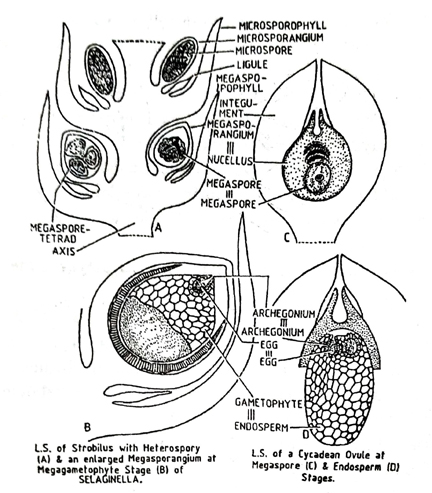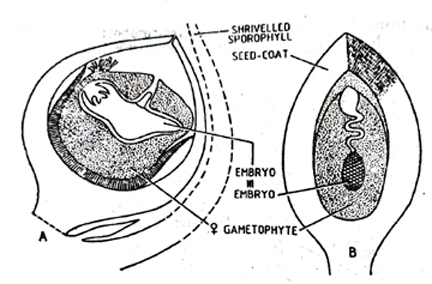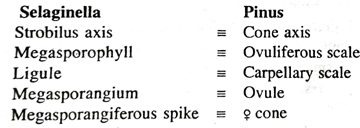What is heterospory? What role it has played in the evolution of seed habit.
Q. What is heterospory? What role it has played in the evolution of seed habit.
Ans. Heterospory: This is an act of the production of 2 different kinds (i.e. heteromorphic) of spores that are dissimilar in shape, size and number (i.e., total output). For example, microspores being too much smaller are produced abundantly per microsporangium, while the total output of bigger megaspores per megasporangium varies from 4 to 1.
Biological significance of Heterospory: The heterospory is directly attributed to the differentiation of sex in the prothallial gametophyte i e., the microspore germinates to develop microgametophyte bearing an antheridium; likewise the megaspore can develop megagametophyte bearing an archegonium/archegonia. So the gametophyte is strictly dioecious in heterospory.
Origin of Heterospory: On the basis of fossil and experimental evidences, this has been concluded that the heterosporous habit arose as a result of the disintegration of a certain number of spores and consequently better nutrition to the surviving one. Hence the nutritional factor is actually concerned in the manifestation of heterospory.
In this context Goebel (1930) was of the opinion that the heterosporous plants of Selaginella growing in shade produced only microsporangia bearing microspores.
Role of heterospory in seed-habit
(i) Heterospory is the most important evolutionary development for seedhabit in vascular plants.
(ii) Survival of only one megaspore out of 4 produced in the megasporangium (or nucellus of the ovule in Spermatophytes); this condition is attributed to the better facility of accommodation and nutrition.

Fig. Selaginella: spermatophyte Seed-habit-Equivalency of structures with a Cycadean
(iii) Permanent retention of megaspore within the megasporangium which is nourished by the mother sporophyte. In species like S. apus and S. rupestris, the megaspore is retained permanently inside the sporangium right from the development of megagametophyte to the event of fertilization and consequently till the formation of embryo sporophyte of next generation.
(iv) The homologies of female reproductive organs of Selaginella have also been established to the spermatophytes as follows


Fig. Selaginella: Seed-habit-Equivalency of structure with a Cycadean seed
(1) Features favouring the Seed-habit: In addition to the aforesaid characters of Selaginella (as also shared by the spermatophytes-seed producing plants), a few following facts stand to
(v) The female strobilus of S. atroviridis and S. gracilis with regard to its structure and position of sporangia is comparable to female cone of Pinus:

(vi) Endosporic nature of gametophyte is related to the precocious germination of the spore.
(vii) The development of male gametophyte partly inside the microsporangium and partly out of it may conveniently be compared to Cycas, Pinus, Ginkgo and Gnetum.
(viii) Reduction in size of male gametophyte which is denoted by an antheridium; and presence of a single prothallial cell is also shared by Cycas.
(ix) Strictly dioecious gametophyte is partly or fully dependent on the sporophyte with regard to shelter and nutrition.
(x) The development of suspensor from one of the 2 cells of proembryo, and of embryo from the other cell are the features similar to higher plants.
(xi) All the vegetative and reproductive parts of terrestrial sporophyte, being fully independent of the gametophyte, have well defined vascular strand or strands. These facts lie in conformity with the seed plants.
(2) Failure of Seed formation by Selaginella:
(i) Unlike spermatophytes, there is no histological union between megaspore and megasporangium, and consequently between megagametophyte and megasporangium.
(ii) The homology between megasporangium and the nucellus is erroneous, since the nucellus itself is a component part of ovule (= megasporangium).
(iii) In the advanced stage, the megasporophyll, instead of forming seedcoat-like hard protective covering, gets shrivelled.
(iv) The embryo, instead of showing dormancy for a prescribed period (as it is a rule in all spermatophytes), exhibits viviparous germination (in S. rupestris) soon after its formation.
Although Selaginella fails to form true seed owing to aforesaid draw back, yet it shows a remarkable approach to the ‘seed-habit’ and resembles spermatophytes in several respects.
Follow on Facebook page – Click Here
Google News join in – Click Here
Read More Asia News – Click Here
Read More Sports News – Click Here
Read More Crypto News – Click Here